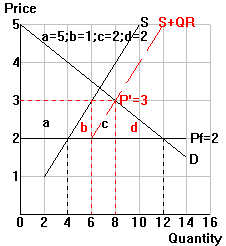Comparing tariffs, quotas and VERs
How are tariffs and quantitative restrictions
similar? For every quantitative restriction (QR) there is an equivalent
tariff, and vice versa.
For example, consider the diagram below for dairy
products (with quantity measured in billions of pounds). The diagram shows
a quantitative restriction of 2 billion pounds which raises the U.S. price
of dairy products from $2 to $3 per pound. A $1 tariff would have had exactly
the same effect on price, production, consumption and imports. The equivalent
tariff also causes the same efficiency loss as the quantitative restriction
(b+d = $3 billion dollars).

How are tariffs and quantitative restrictions
different? The differences between tariffs, quotas and VERs all arise
from what happens to area c in the diagram. Area c is surplus revenue that
comes from selling the restricted imports for a higher price in the home
country than the imports actually cost on the world market. The issue is:
who gets the surplus revenue? (Note: in economics, the term "rent" refers
to revenue in excess of opportunity cost, so the surplus revenue in this
case is commonly referred to as "quota rents.")
With a tariff, area c is kept by the
importing country since it is tariff revenue collected by the government
of the importing country.
With a quota, area c may be kept by
the importing country. That will happen if the importing country government
auctions off the import licenses to the highest bidder or gives all the
import licenses to domestic residents.
With a VER, area c is not kept by
the importing country. The exporting countries get it, since they get to
auction off the trade permits as export licenses or give them to their
own residents.
So, we can rank these three trade policy options
as follows:
A quota is at least as bad as a tariff,
and it is worse if any of the quota rents leak out to exporting countries.
A VER is at least as bad as a quota, and
it is worse if any of the quota rents would not have leaked out
to exporting countries with an import quota.

